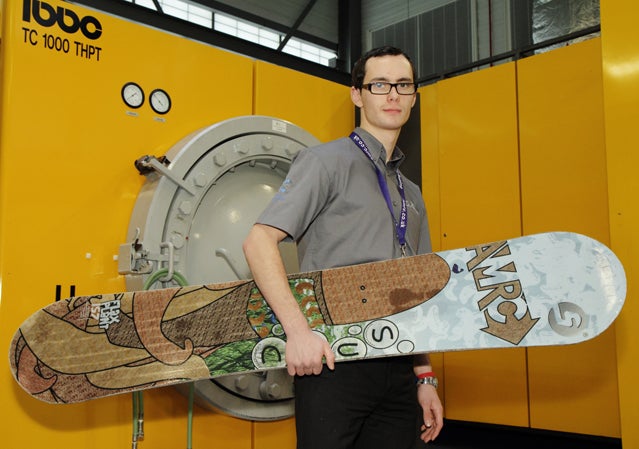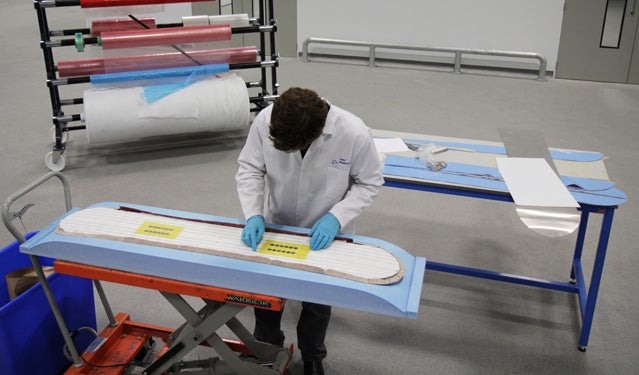
Some day, the researchers at the University of Sheffield's Advanced Manufacturing Research Center (AMRC) will help design lighter, smarter vehicles, from electric cars to airplanes, that will employ bio-based materials with low-environmental-impact and high-performance characteristics that will make travel significantly more energy efficient. For now, however, they're starting with a snowboard.
“We wanted to develop our knowledge with biocomposites,” explains AMRC researcher Alistair Murray. “We wanted to be ahead of the game in terms of our knowledge” of working with biocomposite materials, and what we could offer lab members, he says. (These members include Boeing, Rolls Royce, and a range of other blue chip firms in aviation, transportaion, and defense.) “So we made up some projects where we could get hands-on experience.”
One of these was to create a snowboard using a core made by the Swiss firm Bcomp that is derived from recycled PET (like Coke bottles) and flax fiber. Instead of fiberglass or carbon fiber skins, Murray and his cohorts used flax fibers embedded in a resin containing 30 percent cashew nut husks epoxy. Because Murray was also planning a (ahem) sabbatical in Whistler this winter, he's been strapped with additional work: testing the board. Poor guy.
“We replaced conventional skins with flax fibers, which give slightly better performance than glass fibers in terms of strength-to-weight ratios. They're not as strong or thick as glass fibers but they're also quite a bit lighter, so you use more flax fibers than you would glass fibers but it doesn't end up necessarily heavier,” says AMRC researcher Tim Swait.
Since wood is a renewable resource it's fairly environmentally friendly if it is sustainably sourced, but Swait wanted to use a biocomposite material for the core to keep with the intent of the board's design and creation: learning about biocomposite material characteristics.
Plus, here again the biocomposites have some advantages over conventional snowboard and ski materials, Murray explains: “The core has layers of flax composite and so it's vertically laminated [recycled PET] foam and then a layer of flax and then foam and then layer of flax, all vertically, through the board. So when the skins cure, they make box sections down the length of board so you get more compressive strength than you would from a normal foam core. It should be hopefully the best of both worlds between wood and foam.”
But not all of the attributes of the biocomposite components are better than those used in conventional snowboards and skis. Some things “look better on paper,” admits Murray. The natural materials tend to absorb water, he says. That's obviously a problem. Murray says he's been resealing the binding inserts and sidewalls as much as possible to ensure that the board will stay dry.
Still, while Swait agrees that there are issues to work out, including concerns over durability and some inconsistent quality in the new materials they're using, he says the potential for using biocomposite materials in snowboards or skis is quite good.

A few mainstream board makers are already integrating some bio-based materials into their products. Lib Tech is using a , for example. But startups might see biomaterials as a place to shine. U.K.-based material company Composites Evolution has developed a flax fabric that Canadian startup used in its Bio-Comp board. Another company in the U.K., uses flax in its CarbonLite skis. A startup in Chamonix called is also offering flax and bioresin for its handmade skis.
The surf industry is becoming keen on bio-based and recycled materials as well, and the non-profit Sustainable Surf is pushing along that effort in the U.S.
As for the AMRC board, nicknamed SUSC (Snowboard Using Sustainable Composites—hey, they're engineers, not lit. majors), Murray, who has been very busy riding on his own boards in Whistler, is still tweaking it, getting it ready for its maiden snow voyage. He says it should be ready for the outside world by the end of the month.
For AMRC, developing a biocomposite snowboard was also a move meant to attract young talent to the lab. Murray adds: “A lot of what we do is to try to make the younger generation interested in engineering. Kids might be more interested in snowboards than a turbine blade or something.”
—Mary Catherine O'Connor